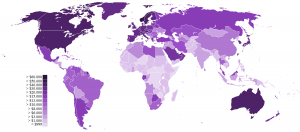Myth Busting: ‘There’s a Best Price for Each Country’
 By Thierry Arrondo
By Thierry Arrondo
Special to YNOT
You’ve heard this question before; maybe you’ve even tried to answer it yourself: “What’s the best price for Country X?”
The problem is, there is no “best price” per country. That’s a myth. Let’s bust it.
Let’s start our myth busting by taking a walk in a park. It’s Central Park in New York. We’ll begin at the Apple Store on the southeast corner. The average annual income for people who live in that postal code is $118,000. By the time we reach the other end of Central Park, the average income is $28,000.
That’s a $90,000 difference—in the space of a park that is in a borough nestled inside a city, which sits in a county that is inside state that sits inside country.
To find a $90,000 difference between countries’ per-capita average annual income, you would have to go from No. 1 (Qatar, the wealthiest) to No. 92 (Anguilla). Most of the world’s population, close to 6 billion people, live between countries 1 and 92.
As a pricing mechanism, country is hardly useful at all simply because the differences between people within countries is too big. There is a world of difference between incomes in Beverly Hills and South Central Los Angeles. Zoom out a little on the map and data shows that people in San Jose, Calif., spend twice as much as people in Los Angeles. Same state, same country, but totally different shoppers. Check your Google Analytics and see if you have similar results.
 Let’s look at country No. 93 (Peru). If someone is on a Mac in Peru, there is a good chance they are among the country’s wealthy elite. The website visitor using a $1,200 laptop is likely much, much wealthier than the $12,000 Peruvian per-capita income would indicate. Maybe that visitor even has a second home near the Apple Store on Central Park. Should you offer this shopper a price based on income of $12,000 a year? Maybe not.
Let’s look at country No. 93 (Peru). If someone is on a Mac in Peru, there is a good chance they are among the country’s wealthy elite. The website visitor using a $1,200 laptop is likely much, much wealthier than the $12,000 Peruvian per-capita income would indicate. Maybe that visitor even has a second home near the Apple Store on Central Park. Should you offer this shopper a price based on income of $12,000 a year? Maybe not.
Location is only one data point to look at when you are trying to understand a visitor. They come at different times of day, on different devices, with different purchasing powers, etc. The differences are endless, if you think about it. Look around you in your city. Would you consider everyone the same? How about everyone in your country?
Online retailers who treat people differently — and provide the best price to each shopper — are significantly widening profit margins. That’s why we stopped pricing per country five years ago. We’re proud of our dynamic pricing results. They’re worth the millions we have invested in better teams, tools and processes.
To quote my uncle, a biology professor, “Adapt or die.”
Thierry Arrondo is managing director for Vendo Services GmbH.













